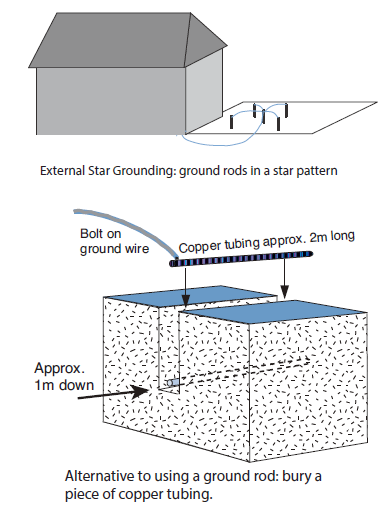The benefits of using a Ground Rod
The whole point of grounding is to dump RFI/EMI out of the system and into a good, low resistance earth. How do you get a good low resistance earth? I know that many of you are connecting your Router to the mains earth: this works well and is simple to achieve, but for very best performance you should connect the Router to an external ground spike or rod, buried in the ground outside.
This answer isn't simple, I'm afraid, because the quality of your earth depends on the soil resistivity which varies with type and situation. If you are lucky, a simple four foot ground spike will do a good job but you may find it more difficult in dry urban situations.
It is worth doing properly, so get a good electrician involved at the beginning who has the measuring equipment to ensure that, whatever lengths you have to go to, you get a reliable low resistance earth.
Ground rod installation – some practical considerations
 Where soil conditions are good (very moist, farming, loamy and clay soils) a single ground rod may well prove sufficient to get a good low resistance grounding connection.
Where soil conditions are good (very moist, farming, loamy and clay soils) a single ground rod may well prove sufficient to get a good low resistance grounding connection.Select a suitable place away from the house (the soil is usually driest near the house) and drive in the ground rod with a lump or sledge hammer - avoid buried pipes and cables! If you have found a good spot, it will drive in easily. If not, then the soil is probably full of rocks or stones that will not make a good earth. If this is the case, search for a spot without rocks. If you can find no soft and easy place, you will need to consider putting in a star network of rods linked together.
Each rod should be further apart than they are deep. Another alternative is to bury a long copper plumbing pipe horizontally about 1m down in a trench. This could be under a lawn, but make the end you connect the earth cable to easily accessible so that you can check the connection regularly.
Whichever technique you apply, consider treating the soil round each rod or pipe with a treatment like magnesium sulphate, copper sulphate, ordinary rock salt or a proprietary conductive concrete such as Marconite®. The best technique is to dig a circular trench round the rod, fill it with the soil-treating material and cover with soil.
Your electrician can solve these problems for you and guarantee the result. Connection to the ground rod should be with a thick copper earth wire (10mm2 or 16mm2) or with our own Technical Ground Weave. Remember to protect the wire in some way to prevent accidental damage that might go unnoticed (gardeners use spades and other sharp tools!).
It might also be wise to fit a plastic pipe through the wall to feed the cable through. It is then easy to seal it with mastic.
Click here to view all grounding products
Click here to view all grounding products






















